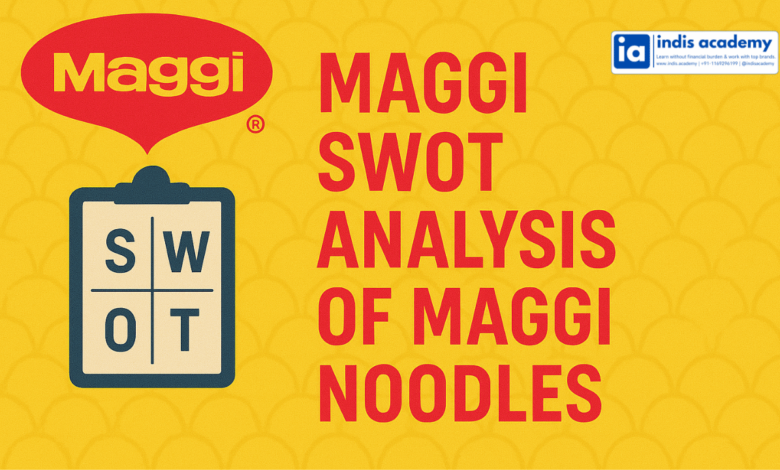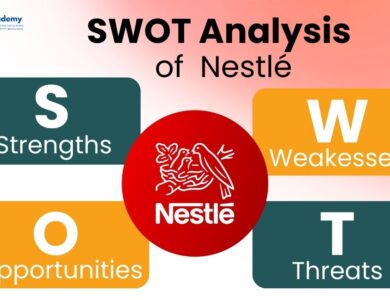SWOT Analysis of Maggi Noodles: From Instant Fame to Brand Challenges

If there’s one name that instantly brings back memories of childhood, college hostel days, and midnight cravings—it’s Maggi. For decades, Maggi noodles have been more than just a snack; they’ve been a warm bowl of nostalgia in Indian homes. Launched by Nestlé, Maggi quickly became a staple in the Indian kitchen, symbolizing comfort, convenience, and emotion.
But while the brand still enjoys unmatched love, it has also faced its fair share of challenges—most notably the infamous 2015 ban. Despite the crisis, Maggi made a powerful comeback and remains a leader in the instant noodle segment.
In this article, we’ll take a deep dive into the SWOT Analysis of Maggi Noodles—exploring its Strengths, Weaknesses, Opportunities, and Threats. You’ll also discover how Maggi bounced back from adversity and continues to innovate in a highly competitive FMCG market.
So, let’s peel back the yellow wrapper and explore what makes (and breaks) this iconic brand.
Learn AI & Digital Marketing,
Pay Fees After Placement
- ✅ Minimal Admission Fees
- ✅ No Loan or Income Sharing Agreement
- ✅ 100% Placement Support
- ✅ ISO & Govt Registered Certificate
- ✅ Practical 3+1 Months Duration
Get a free counseling call. We’ll guide you through learning, certification, and job placement.
Request a Free Call Back
Takes less than a minute.
Brand Overview of Maggi
Maggi, originally a Swiss brand, was acquired by Nestlé in 1947 and made its way into the Indian market in 1983. It didn’t take long for Maggi to become a household name, revolutionizing the concept of “2-minute noodles”—a tagline that became iconic across generations.
Over the years, Maggi has expanded beyond noodles into a diverse product line, including soups, sauces, pasta, masalas, and ready-to-cook meals. Yet, the classic Maggi Masala Noodles remains its crown jewel, with deep emotional resonance in Indian culture.
Today, Maggi holds a dominant position in the Indian instant noodle market, with a market share of over 60%. It is also exported to multiple countries across Asia, Africa, and the Middle East, making it one of the most recognized food brands under the Nestlé umbrella.
Despite challenges, including a major brand trust crisis in 2015, Maggi has not only recovered but also strengthened its presence through innovation, nostalgia marketing, and deep rural penetration.
Maggi vs Key Competitors in India
| Brand | Parent Company | Popular Products | Market Position |
|---|---|---|---|
| Yippee | ITC Limited | Magic Masala, Mood Masala | 2nd largest competitor |
| Top Ramen | Nissin Foods | Curry Veg, Chicken | Popular among urban youth |
| Knorr Soupy Noodles | Hindustan Unilever | Soupy Noodles | Niche segment |
| Patanjali Atta Noodles | Patanjali Ayurved | Wheat-based noodles | Ayurvedic/health-focused |
What is SWOT Analysis?
A SWOT analysis is a strategic tool used to evaluate a brand’s position by examining four key areas:
- S – Strengths: Internal advantages that give the brand a competitive edge
- W – Weaknesses: Internal limitations that may hinder performance
- O – Opportunities: External trends or gaps the brand can capitalize on
- T – Threats: External challenges or risks that could harm the brand
For a brand like Maggi, which is deeply rooted in consumer emotions yet operates in a fast-changing FMCG landscape, a SWOT analysis provides a clear snapshot of where it stands today—and how it can evolve tomorrow.
This framework helps uncover what drives Maggi’s success, what challenges it faces (like health perceptions and brand controversies), and what potential lies ahead in areas like product innovation and global expansion.
Now, let’s dive into the detailed SWOT analysis of Maggi Noodles—starting with its biggest strengths.
Maggi’s Strengths
Maggi isn’t just a product—it’s a part of Indian culture. Its widespread popularity and emotional connect with consumers have helped it maintain a dominant position in the instant noodle segment. Let’s explore the key strengths that keep Maggi ahead of the curve:
💛 1. Unmatched Brand Recall & Emotional Connect
For most Indians, Maggi is more than a snack—it’s a feeling. The phrase “2-minute noodles” became synonymous with quick comfort food, building strong brand recall across all age groups.
📦 2. Wide Product Range & Innovation
Though best known for its classic Masala Noodles, Maggi has successfully expanded into oats noodles, atta noodles, pasta, instant soups, masalas, and ready-to-cook recipes, offering variety while keeping its identity intact.
🏆 3. First-Mover Advantage in India
Maggi was the first brand to introduce instant noodles to the Indian market in the 1980s. This head start helped it build a loyal customer base and dominate shelf space in retail stores nationwide.
🚚 4. Extensive Distribution Network
Thanks to Nestlé’s robust FMCG logistics, Maggi is available in over 4 million retail outlets across India—from metro cities to remote villages. This widespread availability plays a huge role in its sustained dominance.
📢 5. Powerful Marketing and Campaign Strategy
Maggi’s nostalgic and emotional marketing—featuring taglines like “Mummy, bhookh lagi hai” and campaigns like #MeAndMaggi—have successfully connected with consumers across generations.
🌍 6. Strong Global Backing from Nestlé
Being under the Nestlé umbrella gives Maggi access to financial strength, R&D resources, international experience, and cutting-edge supply chain infrastructure—adding to its competitive advantage.
These strengths have helped Maggi not only retain customer loyalty but also bounce back from crises with more love and trust than ever before.
Maggi’s Weaknesses
While Maggi enjoys massive popularity and emotional loyalty, it isn’t immune to brand vulnerabilities. These internal challenges, if left unaddressed, could affect its long-term growth and consumer perception.
⚠️ 1. Health Concerns and Negative Perception
Despite its popularity, Maggi often faces criticism for being unhealthy—due to high sodium content, use of refined flour (maida), and additives. Health-conscious consumers are increasingly shifting away from packaged instant foods.
⚠️ 2. Past Controversies (2015 Ban)
The 2015 nationwide ban over allegations of excess lead and MSG shook consumer trust. Though Maggi eventually bounced back, the episode remains a reminder of how quickly public sentiment can turn.
⚠️ 3. Overdependence on One Core Product
Even though Maggi has diversified, the brand is still largely associated with instant noodles. This over-reliance makes it vulnerable if consumer preferences shift or if a health scare arises again.
⚠️ 4. Slow Product Innovation Compared to Competitors
Brands like Yippee and Top Ramen are often quicker in launching flavor-rich or healthier variants, while Maggi sometimes plays catch-up—risking the loss of younger, adventurous consumers.
⚠️ 5. Limited Appeal in Western Markets
While Maggi is strong in Asia and Africa, it hasn’t made a major dent in Western instant food markets, where consumer preferences, cooking habits, and competition differ significantly.
These weaknesses don’t take away from Maggi’s legacy but point to areas where innovation, transparency, and health positioning can help future-proof the brand.
Maggi’s Opportunities
In a rapidly changing food and health landscape, Maggi has multiple avenues to grow, evolve, and strengthen its leadership position. Let’s take a look at the key opportunities the brand can leverage in the coming years:
🌿 1. Health-Focused Product Development
With more people seeking low-fat, low-sodium, high-fiber options, Maggi can expand its range of healthier variants—such as millet noodles, gluten-free versions, or fortified snacks targeting kids and fitness-conscious adults.
🌍 2. Deeper Penetration into Rural & Tier-3 Markets
Maggi already has a wide rural reach, but there’s room for growth through small SKUs, low-cost packs, and regional flavor variants. These customizations can help capture untapped segments in India and emerging markets abroad.
🛒 3. Expansion into Quick-Cook & Ready Meals
The ready-to-eat and ready-to-cook category is booming. Maggi can grow beyond noodles into full meal kits, pre-seasoned rice, or instant Indian curries—especially appealing to busy professionals and students.
🤝 4. Collaborations with Food Delivery & Cloud Kitchens
Partnering with Swiggy, Zomato, and cloud kitchen brands can bring Maggi-based recipes (Maggi biryani, Maggi pizza, etc.) to urban audiences who love nostalgic fusion food.
🌱 5. Eco-Friendly Packaging & Sustainability
With Gen Z increasingly valuing sustainability, Maggi has an opportunity to adopt recyclable packaging, reduce plastic use, and align itself with environmentally-conscious branding.
By tapping into these opportunities, Maggi can reinvent its classic identity while staying relevant in a fast-moving, health-aware, and experience-driven food market.
Maggi’s Threats
Despite being a market leader, Maggi operates in a highly sensitive and competitive FMCG space. These external threats could impact its brand trust, market share, and long-term growth if not addressed proactively.
⚠️ 1. Intense Market Competition
Maggi faces growing pressure from rivals like Yippee (ITC), Top Ramen (Nissin), Patanjali Atta Noodles, and private-label brands in supermarkets. These brands are more agile in launching new flavors and health-focused variants at competitive prices.
⚠️ 2. Rising Health Consciousness Among Consumers
Today’s consumers are increasingly aware of nutrition, ingredients, and food labeling. As more people opt for whole foods and organic snacks, instant noodles may lose appeal unless reformulated or repositioned.
⚠️ 3. Regulatory & Safety Scrutiny
After the 2015 controversy, food regulators are more cautious than ever. A minor quality slip-up or a misleading claim can trigger instant backlash, bans, or even legal action, especially in India’s volatile media landscape.
⚠️ 4. Price Volatility in Raw Materials
Key ingredients like wheat, spices, and packaging materials are subject to inflation and supply chain disruptions. This could affect pricing and profit margins, especially for value packs targeted at low-income segments.
⚠️ 5. Digital-Era Reputation Risks
In the age of social media, negative sentiment spreads fast. Even unverified rumors or viral videos can damage brand credibility overnight—forcing brands like Maggi to stay hyper-aware and responsive online.
To remain on top, Maggi must continue adapting to consumer expectations, investing in product transparency, and being proactive in how it handles public perception and innovation.
How Maggi Recovered From Crisis and Maintains Brand Love
Maggi’s journey hasn’t been all smooth. In 2015, the brand faced its biggest challenge ever when it was banned across India due to alleged excess lead and MSG content. Shelves were cleared, factories shut down, and public trust took a massive hit. For a product so deeply woven into Indian households, this was more than a PR disaster—it was a cultural shock.
But what followed was a textbook brand recovery.
Nestlé responded quickly with transparency, nationwide lab testing, and open communication. Once cleared by regulators, Maggi staged an emotional comeback. The “Welcome Back” campaign, featuring families, college students, and moms celebrating the return of Maggi, hit all the right chords.
🔁 From Crisis to Comeback
- Maggi re-launched in just 5 months after the ban.
- It leveraged consumer nostalgia and emotional storytelling.
- Focus was shifted to product safety, trust, and reconnecting with its original audience.
- Regional flavors, healthier variants, and aggressive retail campaigns helped regain lost ground.
Today, Maggi doesn’t just lead the instant noodle category—it has become a case study in resilience, emotional branding, and customer loyalty.
Conclusion & Final Thoughts
Maggi isn’t just a brand—it’s a part of India’s emotional and culinary fabric. From being a quick fix for hungry students to a comforting bowl of warmth in countless homes, Maggi has earned a place far beyond supermarket shelves.
This SWOT analysis of Maggi reveals a brand that is rich in strengths—iconic recall, massive reach, and deep customer loyalty. Yet, it also faces real challenges, from health concerns to rising competition and changing consumer preferences.
The good news? Maggi has shown it can adapt, bounce back, and evolve. Its comeback after the 2015 ban proved that brand love, when nurtured with transparency and emotion, can withstand even the toughest storms.
As the food industry moves toward healthier, sustainable, and digital-first choices, Maggi must continue to innovate—without losing the flavor of nostalgia that makes it so beloved.





